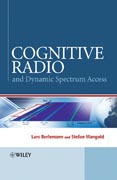
Radio spectrum is not efficiently utilized because of a complicated and time-consuming radio regulation processes and inflexibility in standardization. Examining intelligent technologies to help overcome these barriers, Cognitive Radio for Dynamic Spectrum Access compiles expert guidance towards the applications of cognitive radio and dynamic spectrum access. Written by two experts in the field, with a foreword and cases from the "inventor of cognitive radio," the text includes a free download of the authors' source codes to round out thisgoldmine of information for R&D professionals in industry and academia. INDICE: List of Figures. List of Tables. About The Authors. Foreword. Acknowledgement. Preface. Abbreviations. 1. INTRODUCTION. 1.1 Access to radio spectrum. 1.2 Artificial spectrum scarcity from unexploited frequencies. 1.3 Cognitive radio and dynamic spectrum access as solution. 1.4 This book 28. 2. RADIOSPECTRUM TODAY - REGULATION AND SPECTRUM USAGE. 2.1 History and terminology. 2.1.1 The four basic approaches for radio spectrum regulation. 2.1.2 Guiding principles. 2.2 Institutions that regulate radio spectrum. 2.2.1 International Telecommunication Union, ITU. 2.2.2 Europe. 2.2.3 Germany. 2.2.4 United Kingdom. 2.2.5 Japan. 2.2.6 P.R. China. 2.2.7 United States of America. 2.3 Licensedand unlicensed spectrum. 2.3.1 The disadvantages of spectrum licensing. 2.3.2Unlicensed spectrum as alternative. 2.3.3 Tragedy of commons in unlicensed spectrum. 2.3.4 Spectrum measurements. 3. RADIO SPECTRUM TOMORROW ? DYNAMIC SPECTRUM ACCESS s project GENI. 4.1.3 European project E3. 4.1.4 European project WINNER+. 4.1.5 European project WIP. 4.1.6 European project SOCRATES. 4.1.7 European project ROCKET. 4.1.8 European project ORACLE. 4.2 IEEE coordination, and the Coexistence Advisory Group IEEE 802.19. 4.3 IEEE SCC41/P1900. 4.3.1 IEEE P1900.1. 4.3.2 IEEE P1900.2. 4.3.3 IEEE P1900.3. 4.3.4 IEEE P1900.4. 4.3.5 IEEE P1900.5. 4.4 Wi-Fi Wireless Local Area Networks IEEE 802.11. 4.4.1 IEEE 802.11k for radio resource measurements. 4.4.2 IEEE 802.11n for high throughput.4.4.3 IEEE 802.11s for mesh networks. 4.4.4 IEEE 802.11y for high power Wi-Fi. 4.5 WiMAX Wirless Metropolitan Area Networks IEEE 802.16. 4.5.1 IEEE 802.16.2 Coexistence. 4.5.2 IEEE 802.16h license exempt. 4.5.3 IEEE 802.22 for wireless rural area networks. 4.6 Other standardization activities. 4.6.1 White Spaces Coalition s cognition circle and related cognitive radio definitions. 7.2 Cognitive radios can gain from delay-tolerant software radio. 7.3 DARPA XG provides implementation guidelines, including the access protocol. 7.3.1 Traceabledecision making. 7.3.2 Machine-understandable radio semantics. 7.4 Spectrum etiquette may stimulate cognitive behavior. 7.4.1 What is spectrum etiquette? 7.4.2 Value orientation. 7.5 Network operators may assist dynamic spectrum access. 7.6 Business opportunities. 8 CONCLUDING REMARKS. A. APPENDIX "JEMULA802".B. APPENDIX "YOUSHI". B.1 Modeling QoS requirements and demands. B.2 Resourceallocation and collisions. B.3 Graphical user interface. References. Index.
- ISBN: 978-0-470-51167-1
- Editorial: John Wiley & Sons
- Encuadernacion: Cartoné
- Páginas: 242
- Fecha Publicación: 23/01/2009
- Nº Volúmenes: 1
- Idioma: Inglés
